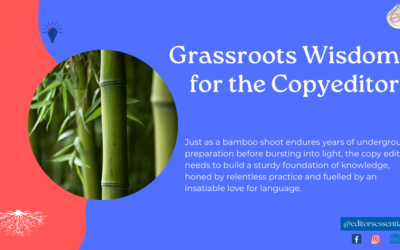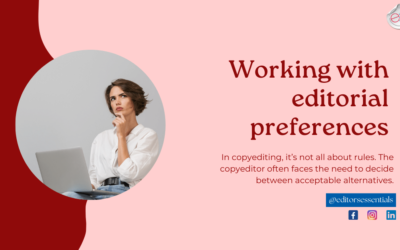Now, we are at the end of a series of posts. A quick recap: in my last post, The making of a copy editor – II, I discussed a good understanding of English grammar and the flair for reading as two of the four traits of a copy editor. While the two are self-explanatory, I urge you to read the previous post, if you haven’t already, and come back here. This post will bring up the other two traits.
Copy editors have an excellent eye for detail. They easily fix inconsistent usage (as in the previous paragraph where “a prospective copy editor” and “prospective copy editors” are both used; not that they are wrong, but that they are inconsistent for no reason) (you also notice that the inconsistency I just mentioned is not in the previous paragraph, but in the previous post). They flag it to the author when the author says there are five characteristics for a noun but lists only four. They get a high when they fix an irrelevant figure placed out of context.
The first trait — a good understanding of the English language — is more about looking out for what is wrong. Having an eye for detail is about catching those unusual and infrequent errors that are prone to be missed even by an ordinary reader. I invite you to a couple of videos to understand this latter trait: Test your awareness: Do the test and Test your awareness: Whodunnit? It’ll take a few minutes and I’ll wait till you come back.
I’m sure you enjoyed those two videos as much as I did. As you would have understood, “It is easy to miss something you are not looking for.” Copy editors are trained and are shrewd enough to not miss “something you are not looking for”.
But is it possible to identify all the 21 changes made in the second video? Perhaps you would have noticed the dancing guerrilla. Making note of twenty-one changes in a couple of minutes, that too when the focus is not on the change but on the murderer, is next to impossible. Can copy editors even imagine doing that? That’s where the fourth trait comes into play: inquisitiveness.
Copy editors have this envious ability to identify such problems at their slightest sight. The moment she thinks there is more to identifying the murderer, her focus is shifted to the portrait or the flower vase or the floor rug. The moment she definitely saw one change, it is more “something you are not looking for”. She indeed is now looking for something.
Consider this sentence:
Cytoscopy was performed rigid.
The first trait tells the copy editor that something is wrong. The word rigid doesn’t really sit well there. We need an adverb there, not an adjective. So we might be tempted to edit the sentence as
Cytoscopy was performed rigidly.
The copy editor instinct says something is awfully awkward there. A quick googling tells us that the word rigid as such is okay, but not its position. The correct edit would be
Rigid cystoscopy was performed.
That is inquisitiveness.

Now to quickly sum up, the four traits are a good understanding of English grammar, a flair for reading, an eye for detail, and inquisitiveness. The good news is that there are plenty of ways to improve each of them. Let’s talk about them later.




Wonderful series, Murugaraj. Way to go!!!